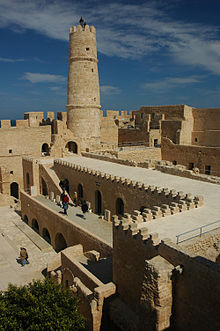里巴特
外观
(重定向自Ribat)

里巴特(阿拉伯语:رِبَـاط ribāṭ)是阿拉伯语词汇的音译,意为基地、旅社、避难所或疗愈所。
里巴特最初是穆斯林征服北非初年时在当地建造的小型边界防御工事,内部为临时志愿兵住所[1],后来成为驿站或保护商路的要塞,也作为孤立穆斯林群体的活动中心。
阿拉伯军队也在拜占庭边界建造这种要塞,以之作为大呼罗珊地区皈依士兵的住所,密集建造该要塞的边界地带自9世纪起称为阿瓦西姆地区。在其他地区也有起类似作用的要塞,在伊朗地区称为khanqah,在土耳其称为tekke[2]。
里巴特的本意是指在边界哨所驻守,驻守者称为穆拉比特(murabit)。基地组织[3]、伊斯兰国[4]等当代圣战者组织也使用这一词汇。加沙地带的萨拉菲运动组织以“里巴特之地”(Arḍ al-Ribat)称呼巴勒斯坦[5]。
参见
[编辑]参考文献
[编辑]- ^ Northedge, Alastair. ʿAbbāsid art and architecture. Encyclopedia of Islam.
- ^ Schimmel, Annemarie. Mystical Dimensions of Islam. University of North Carolina Press. 1975: 231–232. ISBN 0807812234.
- ^ Long, Mark. Ribat, al-Qaeda, and the Challenge for US Foreign Policy. Middle East Journal. Winter 2009, 63 (1): 31–47. doi:10.3751/63.1.12.
- ^ Archived copy (PDF). [2015-06-04]. (原始内容 (PDF)存档于2015-05-18).
- ^ “Radical Islam In Gaza”, International Crisis Group, Middle East Report N°104, 29 March 2011, p. 7; see also note 61 (PDF).https://www.ecoi.net/en/file/local/1059351/1226_1301926747_104-20radical-20islam-20in-20gaza.pdf
- Cache of The Ribat by Hajj Ahmad Thomson, 23 06 2007.
- "The Ribats in Morocco and their influence in the spread of knowledge and tasawwuf" (页面存档备份,存于互联网档案馆) from: al-Imra'a al-Maghribiyya wa't-Tasawwuf (The Moroccan Woman and Tasawwuf in the Eleventh Century) by Mustafa 'Abdu's-Salam al-Mahmah)
- Majid Khadduri, War And Peace in the Law of Islam (Baltimore, Johns Hopkins University Press, 1955), ISBN 1-58477-695-1. p. 81.
- Hassan S. Khalilieh, "The Ribat System and Its Role in Coastal Navigation," Journal of the Economic and Social History of the Orient, 42,2 (1999), 212-225.
- Jörg Feuchter, "The Islamic Ribаt - A Model for the Christian Military Orders? Sacred Violence, Religious Concepts and the Invention of a Cultural Transfer," in Religion and Its Other: Secular and Sacral Concepts and Practices in Interaction. Edited by Heike Bock, Jörg Feuchter, and Michi Knecht (Frankfurt/M., Campus Verlag, 2008).
外部链接
[编辑]- Branning, Katharine. The Seljuk Han of Anatolia. [2 May 2021]. (原始内容存档于2005-02-05). With a map and list of Seljuk hans.
- Introduction and definition (页面存档备份,存于互联网档案馆)
- Origins of the Han (页面存档备份,存于互联网档案馆). The evolution of stopping posts from the Ancient Near East, through the Early Muslim ribats, to the Seljuk han (Turkish for caravanserai); with a list of "Great Seljuk era hans and ribats in Central Asia and Iran"
- ArchNet (页面存档备份,存于互联网档案馆): Origin and layout of a ribat and its adaptation as a caravanserai. Accessed May 2021.
